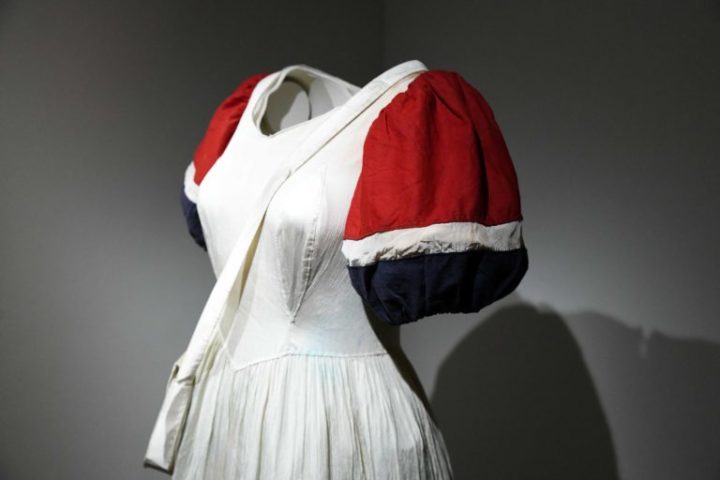July 22, 2024
The making of Luxury: Homemade Luxury in time of crisis Exhibition

Homemade Luxury in time of Crisis: Two Dresses sewn for the Liberation Day of Paris, 26th August 1944.
Paris, Musée de la Libération de Paris-Musée Général Leclerc-Musée Jean Moulin, by Sylvie Zaidman and Marie Olivier.
©ICOM Costume 2022
Voice over Rebecca Devaney
Photograph Krystal Kenney
Dress of Maguerite Sabaut with accessories:
In 1944, as the liberation of France approached, Marguerite Doumeng made, in a time of great scarcity, a patriotic dress in white fabric with blue and red ruffles. To ensure the fall of the skirt, period newspapers form the lining. The dress is adorned with drawings on paper of the monuments of Paris: the Arc de Triomphe, the Sacré-Coeur, Notre-Dame and the Eiffel Tower. Mrs. Doumeng wore this dress at the August 26, 1944 parade in Paris. On that day, a soldier of the French Forces of the Interior and a soldier of the Leclerc division symbolically signed his sleeve with a clasp in the shape of the cross of Lorraine. The young woman also made tricolor crochet earrings, a satin bow decorated with allied flags, and an embroidered handkerchief. With a degree in English and a housewife, Marguerite Doumeng became an interpreter for the Allied forces. This acquisition is exceptional and evokes the jubilation of the liberation of Paris. Sylvie ZAIDMAN.
Child Dress:
Madeleine Brun was born Gaschet in Paris (1942-12-28), the eldest of the family. His father, who worked at the RATP, was mobilised in 1939, sent to North Africa, demobilised in 1940 and worked again at the RATP; his mother Jeanine, née Henry, had a printing press in Châtillon, at n° 24 rue des Bergers. His parents married in 1940 or 1941. Sent to Germany (STO) in Berlin, Mr. Gaschet escaped, was captured and imprisoned in Clermont-Ferrand. However, false papers were issued to him in the name of Maurice Galland, a journalist in Nice, because he was part of the “Anti-Axe” network, like his wife Jeanine, who put her printing press at the service of the Resistance. In 1944, Madeleine was placed with her grandmother, the housekeeper of the Kindal household (Swedish cutlery manufacturers) in the hamlet of Boileau, a small passage in the 16th arrondissement of Paris. Pauline Henry, her grandmother, sews the little blue-white-red dress by hand herself, probably from a sheet that she dyes. Madeleine wore it on August 25, 1944.
References:
Dress, Marguerite Sabaut, 140 x 120 cm, Gift Jean-Jacques Sabaut /Musée de la Libération de Paris-Leclerc-Moulin/Paris Musées, Inv. 2016.8.1.1.
Hand bag, 18 x 24,4 cm, Gift Jean-Jacques Sabaut /Musée de la Libération de Paris-Leclerc-Moulin/Paris Musées, Inv. 2016.8.1.2. https://www.parismuseescollections.pa…
Child Dress, worn by Madeleine Gaschet 26th August 1944, Cotton, 46 x 55 cm, Musée de la Libération de Paris – Musée du général Leclerc – Musée Jean Moulin, Inv. 2021.4.1, Gift Madeleine Françoise Gaschet-Brun.
Acknowledgments:
Guilhem TOURATIER, responsable des collections du Musée de la Libération de Paris-Musée du général Leclerc-Musée Jean Moulin
Sylvie ZAIDMAN, docteur en Histoire, conservateur général du patrimoine, directrice du Musée de la Libération de Paris-Musée du général Leclerc-Musée Jean Moulin
Marie OLIVIER, membre ICOM Costume